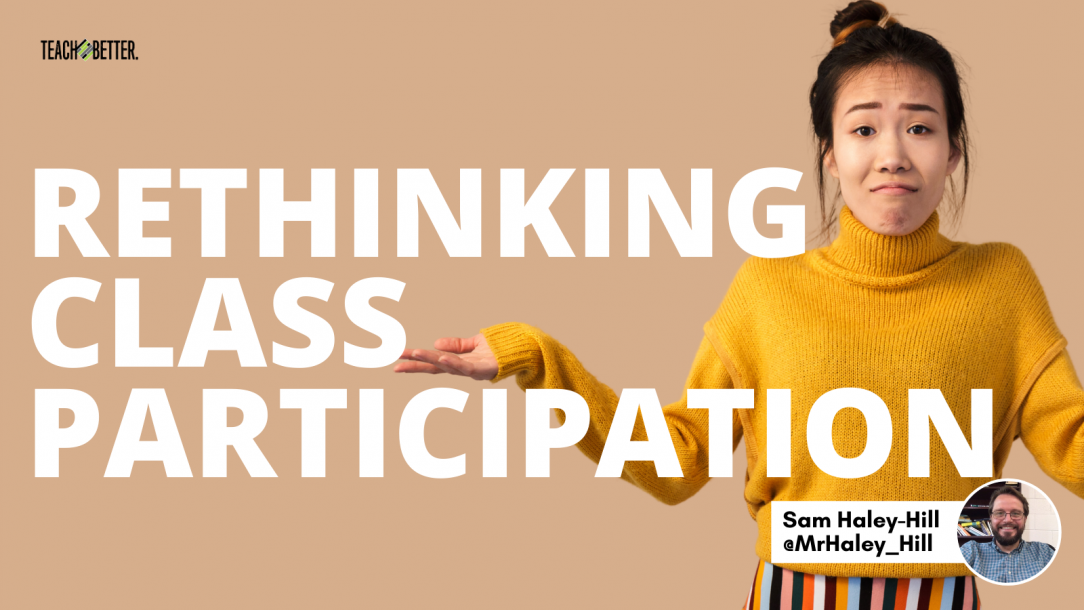TL;DR:
- Remote and hybrid learning environments demand that we reconsider our understanding and perspective of class participation.
- There are many different ways students can participate, a number of which that don’t involve verbal interactions.
- Participation is shown through volunteering answers, asking questions, following the teacher’s instructions, completing work in a timely manner, helping others, actively listening, coming to class with the necessary materials, and taking notes.
Remote and hybrid learning environments demand that we reconsider our understanding of class participation.
Class participation is not easily defined. There is certainly an abundance of research on the effects of class participation and various methods of encouraging it, but teachers often discuss class participation without much examination of what it actually means.
I have heard the term used to refer to students asking questions and participating in verbal discussion, but Professor Stephanie Vandrick argues that a purely verbal understanding of class participation will marginalize, among others, English language learners. Vandrick calls for a widening of our definition of participation. In an era of hybrid and remote learning, we definitely need to conceive of class participation more broadly.
All of this means that we need to look for wider definitions of participation and consider how we might leverage them to create opportunities for remote learners that carry low levels of social risk. Click To TweetAn NYU study finds that class participation is correlated strongly with achievement.
In that study, students report that the number one barrier they feel to class participation is fear of embarrassment. This should already be encouraging us to form new avenues for participation that are not as fraught with social pitfalls as speaking up in front of everyone. In a remote or hybrid setting, the barriers become significantly higher. Being embarrassed in class is one thing, but unmuting yourself to be embarrassed in front of a big video call is somehow even more awkward.
If you’ve ever tried to have an entirely verbal class discussion with 30+ students, you know that an unstructured verbal exchange is going to yield less than ideal results. This will often result in what Jennifer Gonzalez calls the “fisheye syndrome.” Some students will talk a lot, whereas many others will fade into the background. If those faders are remote, there is no way to be sure that they are not checking out completely. Still, student participation is vital, so we need new ways of getting students to participate.
All of this means that we need to look for wider definitions of participation and consider how we might leverage them to create opportunities for remote learners that carry low levels of social risk.
A 2015 study of participation amongst English language learners defines class participation as “playing an active role in all in-class activities.” This is a considerably wider but somewhat vague definition. What do we mean exactly by an “active role”?
The study provides the following ten criteria for measuring this in an ESL class (edited slightly for clarity).
- Participating in course content activities appropriately and proactively, according to type (e.g. pair/group/class discussions, role-plays, presentations, etc.).
- Volunteering answers to teacher questions about the course content.
- Asking the teacher questions about the course content.
- Following the teacher’s instructions or giving instructions to others.
- Making an effort to fully complete in-class activities in a timely manner.
- Using English at all times, including downtime in the classroom (e.g. small talk while an activity is being set up).
- Helping others who are having trouble with course content.
- Active listening during lectures.
- Coming prepared with the necessary materials (e.g. textbooks, homework (if given), preparatory materials required to complete in-class activities).
- Taking notes about course content.
That’s a lot of ways to participate. Notice that all of them can be achieved without necessarily having a verbal exchange. Let’s consider each of them individually as prospects for remote/hybrid student participation.
Participating in course content activities appropriately and proactively.
This is quite broad, so there are plenty of nonverbal ways to do it. Can students respond to questions in writing? Perhaps all students can post answers to a question on a shared document, spreadsheet, or forum. Can we create course content activities that students can complete asynchronously? Stacey Roshan has an excellent example of how students can collaborate on solutions to problems asynchronously using Flipgrid.
Volunteering answers to teacher questions about course content.
It is important to create opportunities for students to proactively volunteer to answer questions, but why does this have to be verbal and/or synchronous? There are numerous ways to capture students’ answers to questions differently. Most video meeting software has a poll function. A simple shared document or spreadsheet can do the trick as well. Self-paced assignments can give students optional opportunities to respond to teacher questions asynchronously; Pear Deck is great for this.
Asking the teacher questions about course content.
Again, this does not necessarily have to be synchronous hand-raising followed by a verbal question. Can students ask questions in the written chat during synchronous sessions? Can their questions be captured in a Google form, class forum, or even a simple email?
Following teacher’s instructions or giving instructions to others.
Ooh, this one gets me excited. Not so much the first bit, but the opportunity to instruct others is an excellent way to foster participation. When your students head to a breakout room or small group, does that group have a leader? Do the students have instructions for how to determine who the leader is? I like to give the students a transparently random method of choosing a breakout room leader (the last person to see a dog) in order to potentially give all students a small leadership role. This requires students to be proactive and engaged.
Making an effort to fully complete in-class activities in a timely manner.
This one is fairly vague, but I can get on board with giving students a defined timeframe for doing things. This tends to produce a certain amount of urgency. If students are working diligently to complete a task, they are participating.
Using English at all times, including downtime in the classroom.
This one is specific to learning a foreign language (in this case, English), but the idea that students are engaging in certain classroom practices at all times makes sense as a participation strategy. In my English language arts classes, for example, students are expected to annotate everything they read as a matter of routine.
Active listening during lectures.
This is, in fact, a form of participation. The real trick is fostering and monitoring active participation. Again, Pear Deck is phenomenal for this as it requires students to actually do a thing as they take in a lecture. Shared note-taking documents, video call polls, spot checks for understanding, and exit tickets are all ways of quickly checking for active listening.
[scroll down to keep reading]
Helping others with course content.
Again, it’s always amazing when students can participate through leadership. If there is a way for you to put students who are excelling alongside students who are struggling, you are potentially empowering everybody and creating a classroom environment built around cooperation and mutual support. I love this.
Coming prepared with the necessary materials.
Preparation as class participation is an unusual idea to me, but it makes sense. A student is taking an active role in my class if they are preparing for it. This means that we might conceive of homework not as an exchange of effort for points, but as a way of demonstrating participation in the learning process.
Taking notes about course content.
Heck yes. If a student is actively writing their own understanding of course content down, I’m happy to call that participation. As long as the note-taking is an act of interpretation and engagement rather than an act of transcription, that student is taking an active role.
Final Thoughts
Students still need to participate in class. There is no way around this. While it is difficult to replicate the verbal discussions of fully in-person learning environments, a little flexibility can go a long way towards fostering diverse types of participation. If we’re being honest, it was probably best to offer varied paths to participation even before all this remote learning started to happen. The necessity we are facing now can be the mother of invention for the time when we’re all back together.
About Sam Haley-Hill
Sam Haley-Hill is has been an official full-time educator since 2011, but started teaching informally while still a high school student. He earned a BA from UC Berkeley and a Master’s Degree from Brown. He’s been a national circuit policy debate coach since 2002 and is one of only a handful of active coaches to have won’t the Tournament of Champions in policy debate with two different schools. He was recognized for his efforts in a 2013 resolution form the Sacramento City Council. In addition to running debate programs, Sam teaches English language arts at the high school level, running the gamut from ninth grade on-level English to twelfth grade AP Literature.



